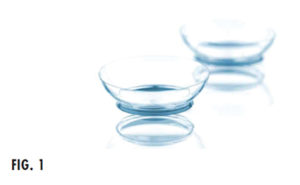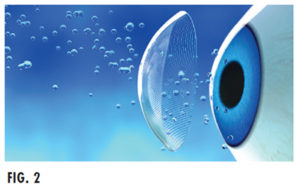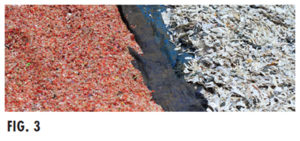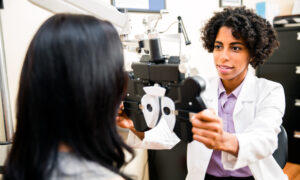January 20, 2023
By Linda Conlin, ABOC/NCLEC
Release Date: June 1, 2022
Expiration Date: May 19, 2023
Learning Objectives:
Upon completion of this program, the participant should be able to:
- Understand recent developments in contact lenses to improve vision and eye health.
- Learn how contact lenses have even more functions and benefits.
- Learn about contact lenses under development that enhance vision via mobile device control and augmented reality vision.
Course Description
There’s something new in contact lenses almost every day. Research continues not only to improve vision and eye health but for contact lenses to have even more functions and benefits. This course reviews the latest innovations.
Credit Statement:
This course has been approved for 1 Hour, Technical Level II. Course number: CTWJHI110-2, continuing education credit by the NCLE (National Contact Lens Examiners).
There’s something new in contact lenses almost every day. Research continues not only to improve vision and eye health but for contact lenses to have even more functions and benefits. Here are some of the latest innovations.
MATERIALS AND SURFACE TREATMENTS
The key to contact lens comfort is to eliminate lens awareness, which is most often due to lens dryness. Natural tear film lubricates, smooths and protects the ocular surface. The closer a contact lens can mimic the ocular surface, the more comfortable it will be, and the healthier it will be for the eye. For wearers of reusable contact lenses, improvements in lens materials to maintain water content and in surface treatments help lenses stay comfortable for the entire period of usage. Daily disposable wearers already enjoy those benefits, and now so can wearers of planned replacement lenses. Contact lenses also can provide relief for allergy sufferers. Daily disposable lenses that have built-in lubricants act as a barrier to irritants to reduce symptoms of itching, burning, stinging and redness.
Dry eye syndrome used to be a contraindication for contact lenses, but now, contact lenses can actually aid in management of the condition. Some silicone hydrogel lenses have on-eye wettability. It is a surface treatment that accommodates tear film behind the lens and reduces the friction between the lids and the lens for better comfort. Some new lenses have a water and oxygen content similar to that of the cornea. Their surface treatment is designed to mimic the lipid layer of the tear film. Contact lenses with molecular imprinting are becoming available. CooperVision Proclear lenses contain phosphorylcholine (PC) molecules that bind with water molecules in natural tears to create a “shield” of water around the lens. In addition, researchers are developing daily disposable and silicone hydrogel lenses imprinted with an adjustable release comfort agent. And research is underway to develop contact lenses that improve tear fluid volume to aid in the management of ocular diseases like dry eye syndrome.
Another contact lens innovation for dry eye involves monitoring. In 2020, researchers at the Shenzhen Institute of Advanced Technology (SIAT) of the Chinese Academy of Sciences found a different approach to “smart” contact lenses. They developed a contact lens that can show real-time changes in eye surface moisture and intraocular pressure by changing colors.
The lenses are made of pHEMA hydrogel, a material researchers emphasize is identical in structure to an FDA approved contact lens material already in use worldwide, but the color change occurs without any chemical pigments. Researchers refer to the lenses as “structurally colored.” Reflective properties of nanostructures, which are of intermediate size between microscopic and molecular structures, are within the hydrogel matrix and produce color changes from red to green to blue. The color variation is in response to differences in the reflectance wavelengths caused by changes in eye surface conditions. Under normal conditions, the lenses do not change from their normal red color, but with xerophthalmia, a condition in which the eye fails to produce tears, the lenses turn blue. Increased intraocular pressure will also change the reflective properties of the lenses, turning them blue as well.
The lenses currently are designed as a diagnostic tool for point-of-care (POC), rather than for constant wear, with color change occurring in about 25 minutes under test conditions. Early diagnosis and treatment of eye disease is key to preserving sight, but present diagnostic testing for elevated intraocular pressure and xerophthalmia can involve the use of instruments and complex procedures. Researchers hope the lenses will provide easier, instrumentfree testing for those conditions, resulting in greater patient comfort. They anticipate that, “structurally colored materials, …will contribute to desirable progress in the field of diagnostics.” What’s more, Prof. DU Xuemin, leader of the research group, believes, “It will also inspire the design of a new generation of wearable devices with colorimetric sensing capabilities for real-time POC monitoring of various human body signs and diseases.”
MYOPIA MANAGEMENT
We’ve all heard about the increasing incidence and progression of myopia in children. There are ways in which contact lenses can help control that progression. Multifocal contact lenses have been used off-label to control myopia in children as young as 8 years old, and studies are underway for approval for children as young as 7 years old.
Researchers believe that one reason myopia progresses is due to peripheral hyperopic defocus, in which light focuses behind the peripheral retina, as in hyperopia. This defocus stimulates the growth or elongation of the eye, resulting in myopia. Once again, contact lenses come to the rescue! Soft multifocal contact lenses eliminate the hyperopic defocus behind the retina and create a peripheral myopic focus in front of the retina instead, which slows eye growth. What’s more, CooperVision has developed the MiSight dual focus design daily disposable lens that corrects peripheral defocus. Studies showed it slowed the progression of myopia in children by 59 percent. MiSight is the first lens FDA approved for myopia management, with another manufacturer expecting approval soon for their lens.
So often we see our young nearsighted patients come back every year with a steadily increasing prescription. Rather than continue to increase the minus power of the lenses, studies have shown that reducing the accommodative demands of near vision with bifocal or multifocal lenses can slow the progression of myopia. Experts are uncertain as to whether the benefits of multifocal lenses are due to the better focus of light rays from near objects or better focus of peripheral images as suggested by peripheral hyperopic defocus. In either case, multifocal contact lenses alleviate the accommodative demands in young people and slow the advancement of their myopia as can multifocal eyewear, giving young people choice and flexibility.
 Rigid contact lenses have long been used in orthokeratology (ortho-k) to reshape the cornea overnight to provide uncorrected daytime vision. The lens is worn during the night and flattens the cornea. As you know with myopia, light focuses in front of the retina. Flattening the cornea shortens the distance to the retina, so the light will focus where it’s supposed to. At the same time, peripheral images that focused behind the retina are brought forward. Experts believe that the images focusing behind the retina stimulates the eyeball to elongate, causing myopia. If the elongation of the eyeball can be slowed, it will also slow the progression of myopia. In 2021, the FDA approved Johnson & Johnson’s Acuvue Abiliti, the first ortho-k lens for the management of myopia, and they’re available in spherical and toric designs. The lenses not only provide vision correction but slow the progression of myopia. (Fig. 1)
Rigid contact lenses have long been used in orthokeratology (ortho-k) to reshape the cornea overnight to provide uncorrected daytime vision. The lens is worn during the night and flattens the cornea. As you know with myopia, light focuses in front of the retina. Flattening the cornea shortens the distance to the retina, so the light will focus where it’s supposed to. At the same time, peripheral images that focused behind the retina are brought forward. Experts believe that the images focusing behind the retina stimulates the eyeball to elongate, causing myopia. If the elongation of the eyeball can be slowed, it will also slow the progression of myopia. In 2021, the FDA approved Johnson & Johnson’s Acuvue Abiliti, the first ortho-k lens for the management of myopia, and they’re available in spherical and toric designs. The lenses not only provide vision correction but slow the progression of myopia. (Fig. 1)
PRESBYOPIA
Current estimates are that presbyopia affects approximately 1.8 billion people around the world, and as the world population ages (we’re living longer), that number will rise considerably. Contemporary presbyopia correction with contact lenses includes monovision and multifocal lenses. But what if a contact lens could transition from distance to near vision as seamlessly as our younger eyes? Based on the volume of new patent filings and prototypes, accommodating contact lenses are in our future.
According to a paper published in Contact Lens and Anterior Eye, there are two hurdles to overcome for an accommodative contact lens. First, the user’s gaze must be tracked for changes in viewing distance, and second is control of the focal length. Approximately 2.00 diopters of additional plus power is needed for near vision. That sounds like a tall order, but innovative solutions are in the works.
One method involves a fluid-filled contact lens. Most near gaze is downward, and the lens works on that principle. When the wearer looks down, the lower lid presses on the lens. That pressure causes fluid in the lower part of the lens to move upward, increasing plus power for near vision. Upon distance gaze straight ahead, the fluid returns to the lower part of the lens, and the distance power is restored. An electromechanical pump embedded in the lens to move fluid to change the lens shape and power is also under consideration. Another method similarly uses gaze position to change power. When the lower lid presses on the lens for near gaze, the lens lifts from the cornea and changes shape. More tear film gets behind the lens, and the combination of shape change and increase in the lacrimal lens adds plus power.
What about gaze tracking? For that, we need a different type of lens. Microelectronic sensors embedded in the lens track changes in gaze based on changes in an electrical charge. The changes control the lens optics. Transmission of gaze information to an external device can also control lens power. Like other smart contact lenses, these lenses require a power source and an antenna. Contact lenses using liquid crystal displays (LCDs) are in the pipeline, too. Liquid crystals form parallel rods in their natural state. Reorienting the rods with a low voltage electrical charge changes the refractive index of the lens, and so the power.
Patents and patent applications have been filed for these designs, and clinical trials have been proposed, while some are already under way. It will take much more time and trial before lenses like these are available, but as the technology for contact lens materials and microelectronics progresses, they are on a bright horizon.
DRUG DELIVERY
Did you ever see some of your patients try to apply eye drops? It becomes a very uncomfortable process with heads tilted way back, arms fully extended over their eyes and usually mouths wide open. It’s a wonder that any of the drops actually get into the eye! Research into the use of contact lenses as drug delivery systems continues.
Because the contact lens sits directly on the surface of the eye, it delivers a controlled and continuous dosage of medication where it’s needed, compared to standard delivery through eye drops. With drops, up to 95 percent of the medication can be lost through the eye’s normal drainage mechanism, and most of the medication is gone after just one hour. By contrast, a contact lens containing drugs can still deliver the medication after eight hours. Drug delivery through contact lenses provides a steady and constant medication release, which is especially beneficial in cases of dry eye and glaucoma.
HEALTH MONITORING
Contact lenses to monitor health are already available, and there will be more to come. One is a contact lens, recently FDA approved for marketing in the U.S., named after a fish. The Sensimed Triggerfish contact lens can monitor changes in intraocular pressure for glaucoma patients. While the fish is named for its ability to extend and release spines, the contact lens sensors make a pattern that looks similar to that of the fish. Biosensors embedded in a soft contact lens record changes in the shape of the cornea at the limbus, which indicates a change in intraocular pressure. The sensors continuously transmit real-time data to a wireless device, which can then be transmitted to an eyecare professional. (Fig. 2)
 Not only can contact lenses deliver drugs, they can also monitor the levels of certain substances in the body that are found in tears. Tears contain not only water and salts but also very complex proteins, enzymes, polysaccharides and lipids. Even small changes in tear composition can indicate a state of disease. Contact lenses that monitor and analyze those changes can provide valuable information about the health of the entire body. Researchers believe it is possible to develop contact lenses that analyze biomarkers in tears to monitor other bodily functions and detect diseases such as cancer at early stages.
Not only can contact lenses deliver drugs, they can also monitor the levels of certain substances in the body that are found in tears. Tears contain not only water and salts but also very complex proteins, enzymes, polysaccharides and lipids. Even small changes in tear composition can indicate a state of disease. Contact lenses that monitor and analyze those changes can provide valuable information about the health of the entire body. Researchers believe it is possible to develop contact lenses that analyze biomarkers in tears to monitor other bodily functions and detect diseases such as cancer at early stages.
Glucose is one of the substances found in tears. It is important for diabetics to maintain constant blood glucose levels within normal range. Many diabetics also need vision correction, so a contact lens that not only corrects vision but monitors blood sugar is a great convenience. The lens can transmit the readings to remote devices for interpretation by a health care professional. Glucose monitoring contact lenses that would eliminate finger pricks for diabetics have been and continue to be under development, as are lenses to monitor dry eye.
The technology for these smart contact lenses came from a compound used in smartphones, tablets and televisions. Dr. Gregory Herman of Oregon State University combined a transparent sheet of transistors from this compound with an enzyme that breaks down glucose and then embedded the sheet into a standard soft contact lens. This biosensor was adapted to detect the low levels of glucose found in tears. The enzyme, glucose oxidase, oxidizes the glucose, which changes the pH level of the tears. The change in the pH level changes the current flowing through the transistors. By tracking the changes to the current, glucose levels can be measured. A pretty amazing chain of events!
AUGMENTED VISION
Other contact lenses under development may be able to receive and display images. Researchers can now implant semitransparent LEDs in contact lenses. In the near future, TV or photo images will be projected directly to the eye. Lenses that enhance vision via mobile device and augmented reality vision coupled with mobile device control may be FDA approved in 2022.
Here’s how it works. An antenna receives power from radio waves. The power is stored in an integrated circuit. The LED is in a tiny chip, and Fresnel lenses in the contact lens would allow the wearer to focus on an image literally on the cornea. This technology is being investigated for use in intraocular lenses as well. The comfort and versatility of this technology has exciting implications for patients suffering from low vision and vision loss.
Wearable technology company Mojo Vision announced that it is collaborating with contact lens maker Menicon to develop smart contact lens products. The move marks an important step forward for the California-based company, which for the past three years has been developing the Mojo Lens, a sensor-enabled scleral contact lens that can give the wearer augmented reality viewing capability. The Mojo Lens centerpiece is a hexagonal display less than half a millimeter wide, with each greenish pixel just a quarter of the width of a red blood cell. A tiny magnification system expands the imagery optically and beams it to a central patch of the retina.
A computer chip processes the imagery, controls the display and communicates wirelessly to external devices like a phone. A motion tracker compensates for your eye’s movement. The device is powered by a battery that’s charged wirelessly overnight, like a smartwatch. While Mojo Vision hasn’t specified a timetable for its commercial release, wearable vision technology is developing rapidly on many fronts. Now is the time for ECPs to start thinking about how they might integrate smart contacts into their product mix. (Note: In January 2023, Mojo Vision called off the smart contact lens project to turn its resources to MicroLED display technology.)
The Purdue Research Foundation Office of Technology Commercialization recently secured a patent for a new contact lens technology to help diagnose and monitor ocular health conditions, as reported in ScienceDaily. Like other smart contact lenses, biosensors embedded on the soft contact lenses record electrophysiological activity from the corneal surface. But there’s a difference. Geared for retinal activity, the ultrathin biosensors are stretchable, making them more compatible with the curved shape of commercial soft contact lenses, increasing patient comfort.
The lenses will take an electroretinogram (ERG) that measures the electrical activity of the retina in response to a light stimulus. The ERG is used for the diagnosis or early detection of many ocular diseases such as glaucoma, retinitis pigmentosa, diabetic retinopathy, retinoschisis (splitting of the retina into two layers), detachment and other congenital degenerations. Current ERG devices use a rigid lens with an uneven surface that includes protrusions and requires topical anesthesia. Even with topical anesthesia, however, patients experience discomfort to the cornea and eyelid. In some cases, depending on their tolerance levels, patients require sedation or general anesthesia, increasing the risks of the procedure. But soon, we’ll have a better way.
Using soft contact lenses will allow the lens to better conform to the shape of the eye, have less decentration and movement, and prevent corneal scratching. Conduction paths are located at the lens periphery and connected to an external data collection system through a soft, stretchable, thin, lightweight connection wire. Because a standard soft contact lens is the basis for the device, it affords wettability, biocompatibility and oxygen transmissibility comparable to the lens itself. Researchers reported that the lenses continued to perform well in adverse conditions including overstretching, dehydration, disinfection and temperature variations from 86 to 176 degrees Fahrenheit. Even better, the device provided high-quality ERG recordings. The developers believe that this technology can ultimately be applied to a broad range of clinical procedures such as IOP and eye movement monitoring.
SUSTAINABILITY
More and more consumers are demanding sustainability in their purchases, and that includes contact lenses. Manufacturers have become proactive when it comes to environmental concerns. Three major contact lens companies—Alcon, Bausch + Lomb and CooperVision—have programs currently under way in their ongoing efforts toward sustainability.
Alcon has earned the GreenCircle Zero Waste to Landfill Certification for three of its ophthalmic drop and solutions’ manufacturing facilities—two in Fort Worth, Texas, and one in Singapore. This makes Alcon the first health care company to be GreenCircle Certified for Zero Waste to Landfill operations. Each of the three facilities that earned GreenCircle Zero Waste to Landfill Certification diverted 100 percent of total waste from landfills.
 Bausch + Lomb announced that its One by One and Biotrue Eye Care Recycling programs have recycled a total of 48,235,850 million units, or 290,145 pounds, of used contact lenses, eyecare and lens care materials. These recycling programs gather used contact lenses, eyecare and lens care materials, including contact lens blister packs and top foil. Bausch + Lomb developed these programs in conjunction with TerraCycle, which specializes in the collection and repurposing of hard-to-recycle post-consumer waste, because used contact lenses, eyecare and lens care materials don’t typically end up getting processed in standard recycling facilities. These materials are traditionally sent to landfills, because recycling facilities only accept certain types of plastic and filter out small-sized materials. (Fig. 3)
Bausch + Lomb announced that its One by One and Biotrue Eye Care Recycling programs have recycled a total of 48,235,850 million units, or 290,145 pounds, of used contact lenses, eyecare and lens care materials. These recycling programs gather used contact lenses, eyecare and lens care materials, including contact lens blister packs and top foil. Bausch + Lomb developed these programs in conjunction with TerraCycle, which specializes in the collection and repurposing of hard-to-recycle post-consumer waste, because used contact lenses, eyecare and lens care materials don’t typically end up getting processed in standard recycling facilities. These materials are traditionally sent to landfills, because recycling facilities only accept certain types of plastic and filter out small-sized materials. (Fig. 3)
CooperVision’s plastic neutrality initiative includes its recycling program with Plastic Bank, which gathers ocean bound plastic waste directly from local beaches, riverbanks, neighborhoods and households. CooperVision expects the partnership to prevent the equivalent of nearly 90 million plastic bottles from reaching Earth’s oceans in 2022. The company pioneered the first net plastic neutral contact lenses by funding Plastic Bank’s collection, processing and reuse of general oceanbound plastic waste that is equal to the weight of the plastic contained in orders of designated products in North America and Europe. The plastic neutrality initiative enables Plastic Bank collectors in nearly 200 coastal communities to clean up their towns and villages while earning credits for necessities such as groceries, cooking fuel, school tuition and health insurance.
SUMMARY
New contact lens materials and surface treatments make lenses more comfortable, healthier to wear, and can alleviate symptoms of dry eye and allergies. FDA approval of the use of soft multifocal contact lenses in younger children for myopia control provides a convenient way to slow progression while correcting vision at the age when myopia begins. Improvements in contact lenses for presbyopia are on the horizon, too. Accommodating contact lenses may enable the wearer to transition from distance to near vision as seamlessly as younger eyes can.
Drug delivery through contact lenses provides a steady and constant medication release, which is especially beneficial in cases of dry eye and glaucoma. Not only can contact lenses deliver drugs, they can also monitor the levels of certain substances in the body that are found in tears. Glucose monitoring contact lenses that would eliminate finger pricks for diabetics have been and continue to be under development, as are lenses to monitor dry eye. What’s more, biosensors embedded in a soft contact lens record changes in the shape of the cornea at the limbus, which indicate a change in intraocular pressure.
Contact lenses under development may be able to receive and display images. Researchers can now implant semitransparent LEDs in contact lenses. Lenses that enhance vision via mobile device and augmented reality vision coupled with mobile device control may be especially beneficial to low vision patients.
Contact lens companies have become proactive when it comes to environmental concerns. Manufacturing facilities are designed to be eco-friendly through recycling, sustainable energy, environmentally conscious design and global responsibility. Patients will have a healthy lens-wearing experience while helping the planet.
CONCLUSION
Research and development in contact lenses continue to improve not only visual acuity, but comfort and eye health for current contact lens wearers. But the potential uses for contact lenses are exploding, and as technology can be adapted to work with contact lenses, their function reaches far beyond vision correction alone. Look for something new with contact lenses every day!











